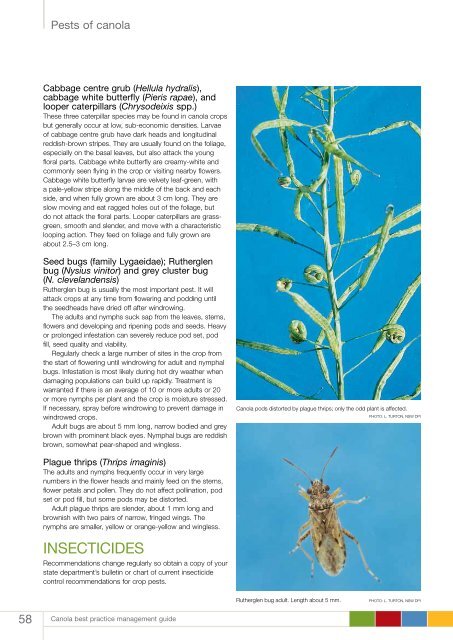best practice management guide for south-eastern Australia - Grains ...
best practice management guide for south-eastern Australia - Grains ...
best practice management guide for south-eastern Australia - Grains ...
You also want an ePaper? Increase the reach of your titles
YUMPU automatically turns print PDFs into web optimized ePapers that Google loves.
Pests of canola<br />
Cabbage centre grub (Hellula hydralis),<br />
cabbage white butterfly (Pieris rapae), and<br />
looper caterpillars (Chrysodeixis spp.)<br />
These three caterpillar species may be found in canola crops<br />
but generally occur at low, sub-economic densities. Larvae<br />
of cabbage centre grub have dark heads and longitudinal<br />
reddish-brown stripes. They are usually found on the foliage,<br />
especially on the basal leaves, but also attack the young<br />
floral parts. Cabbage white butterfly are creamy-white and<br />
commonly seen flying in the crop or visiting nearby flowers.<br />
Cabbage white butterfly larvae are velvety leaf-green, with<br />
a pale-yellow stripe along the middle of the back and each<br />
side, and when fully grown are about 3 cm long. They are<br />
slow moving and eat ragged holes out of the foliage, but<br />
do not attack the floral parts. Looper caterpillars are grassgreen,<br />
smooth and slender, and move with a characteristic<br />
looping action. They feed on foliage and fully grown are<br />
about 2.5–3 cm long.<br />
Seed bugs (family Lygaeidae); Rutherglen<br />
bug (Nysius vinitor) and grey cluster bug<br />
(N. clevelandensis)<br />
Rutherglen bug is usually the most important pest. It will<br />
attack crops at any time from flowering and podding until<br />
the seedheads have dried off after windrowing.<br />
The adults and nymphs suck sap from the leaves, stems,<br />
flowers and developing and ripening pods and seeds. Heavy<br />
or prolonged infestation can severely reduce pod set, pod<br />
fill, seed quality and viability.<br />
Regularly check a large number of sites in the crop from<br />
the start of flowering until windrowing <strong>for</strong> adult and nymphal<br />
bugs. Infestation is most likely during hot dry weather when<br />
damaging populations can build up rapidly. Treatment is<br />
warranted if there is an average of 10 or more adults or 20<br />
or more nymphs per plant and the crop is moisture stressed.<br />
If necessary, spray be<strong>for</strong>e windrowing to prevent damage in<br />
windrowed crops.<br />
Adult bugs are about 5 mm long, narrow bodied and grey<br />
brown with prominent black eyes. Nymphal bugs are reddish<br />
brown, somewhat pear-shaped and wingless.<br />
Canola pods distorted by plague thrips; only the odd plant is affected.<br />
<br />
Photo: L. Turton, NSW DPI<br />
Plague thrips (Thrips imaginis)<br />
The adults and nymphs frequently occur in very large<br />
numbers in the flower heads and mainly feed on the stems,<br />
flower petals and pollen. They do not affect pollination, pod<br />
set or pod fill, but some pods may be distorted.<br />
Adult plague thrips are slender, about 1 mm long and<br />
brownish with two pairs of narrow, fringed wings. The<br />
nymphs are smaller, yellow or orange-yellow and wingless.<br />
Insecticides<br />
Recommendations change regularly so obtain a copy of your<br />
state department’s bulletin or chart of current insecticide<br />
control recommendations <strong>for</strong> crop pests.<br />
Rutherglen bug adult. Length about 5 mm. <br />
Photo: L. Turton, NSW DPI<br />
58 Canola <strong>best</strong> <strong>practice</strong> <strong>management</strong> <strong>guide</strong>

















